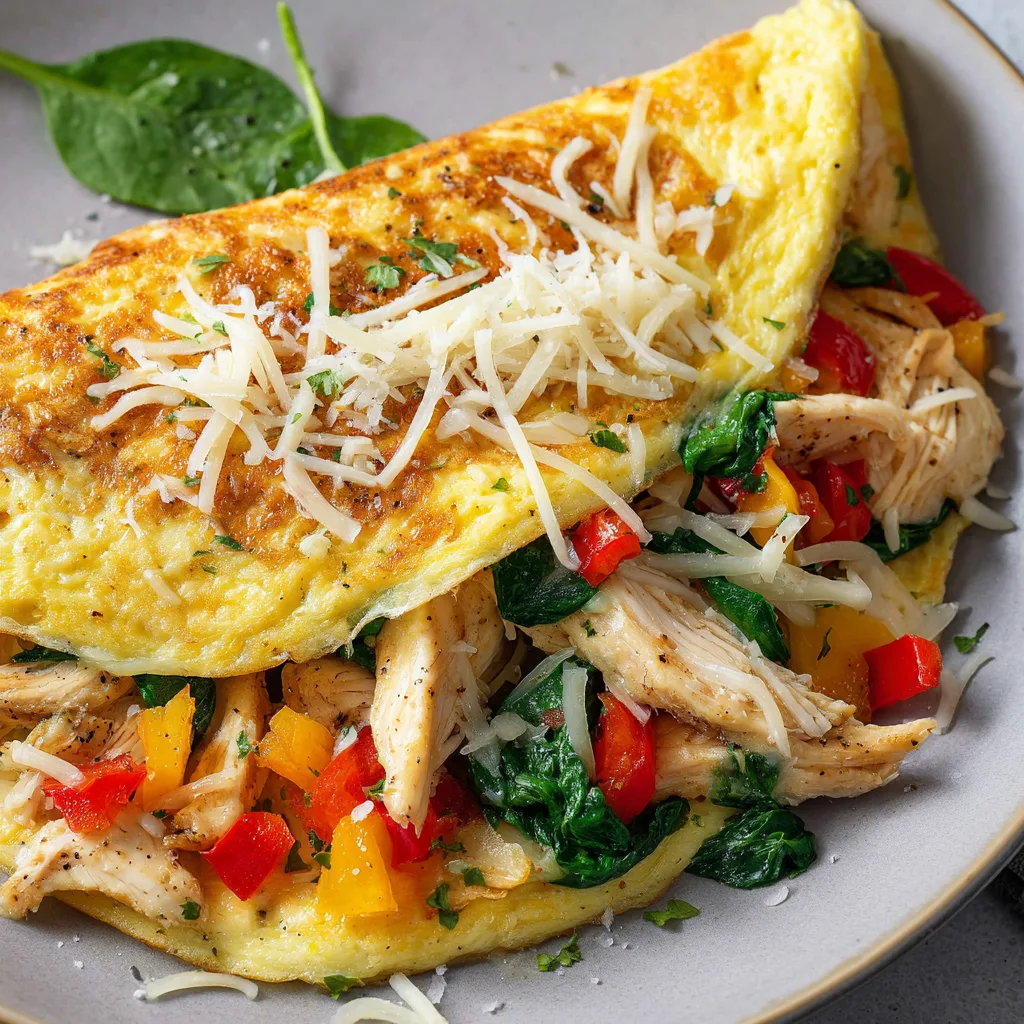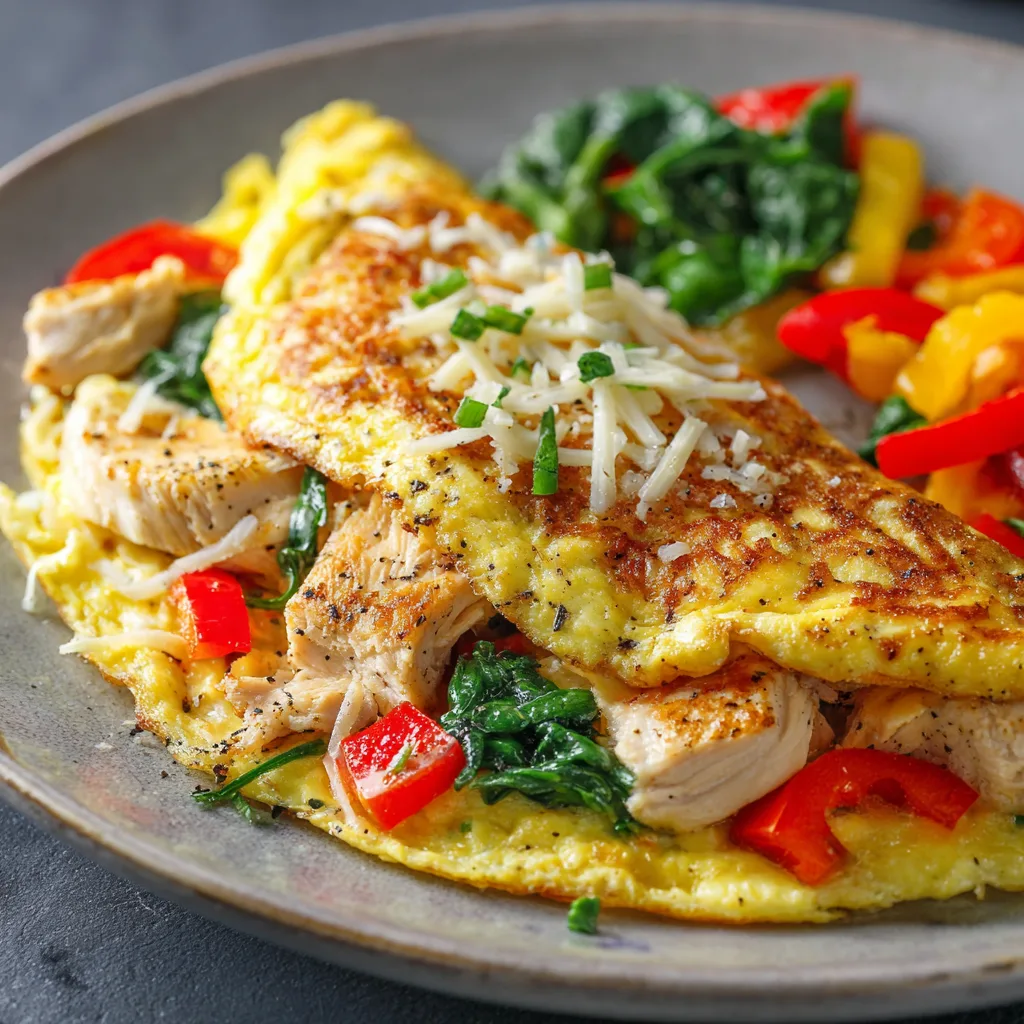Overview of the Low-Carb High-Protein Chicken Omelette Recipe
The low-carb chicken omelette is a flavorful, quick meal packed with protein and essential nutrients. It’s perfect for anyone looking to enjoy a healthy dinner without compromising on taste or time. Combining tender chicken pieces with fresh vegetables and fluffy eggs, this dish balances satisfying flavors with dietary goals. Its low-carb profile makes it ideal for ketogenic or other carbohydrate-conscious diets. Beyond health benefits, the recipe offers great versatility. You can easily swap ingredients, adding your favorite veggies, cheeses, or spices to keep the meal exciting and personalized. Whether you’re cooking solo or for a family, this omelette delivers a nourishing and delicious dinner solution that’s both simple and adaptable.
The Importance of Low-Carb, High-Protein Meals for Optimal Health
Low-carb, high-protein meals support many health goals, including weight control and muscle preservation. By limiting carbohydrate intake, these meals help stabilize blood sugar levels and reduce insulin spikes, contributing to better metabolic health. High protein consumption encourages muscle repair, boosts satiety, and can increase calorie burn through thermogenesis. Nutrition experts emphasize that balanced meals with sufficient protein improve energy levels and keep hunger at bay. Many people following low-carb lifestyles report better focus and sustained energy throughout the day. Including recipes like the chicken omelette in your meal plan supports these benefits while offering delicious flavors that keep healthy eating enjoyable.
Nutritional Benefits of Chicken as a Lean Protein Source
Chicken is an excellent lean protein that fits perfectly into low-carb, high-protein diets. Different cuts of chicken vary in fat and calorie content, with breast meat being the leanest option. Skinless chicken breast delivers high-quality protein with minimal fat, supporting muscle growth and repair. Darker cuts like thighs contain slightly more fat but provide richer flavor and additional nutrients like iron and zinc. Chicken is also rich in essential vitamins such as B6 and niacin, which play roles in energy metabolism. Incorporating chicken into meals ensures a balanced diet by providing ample protein without excess calories, making it a smart choice for those focused on healthy living and fitness.
Essential Ingredients for the Low-Carb Chicken Omelette
This omelette relies on a handful of wholesome ingredients that combine flavor and nutrition. The core components include eggs, cooked chicken, fresh spinach, ripe tomatoes, cheese, and basic seasonings. Eggs form the protein-rich base, providing essential amino acids and healthy fats. Cooked chicken adds lean protein, making the dish more filling and ideal for muscle repair. Fresh spinach contributes fiber, vitamins A and C, and antioxidants, enhancing both taste and health benefits. Tomatoes bring a subtle sweetness and are rich in lycopene, a powerful antioxidant. Cheese adds creaminess and flavor, plus a boost of calcium and protein. Seasonings like salt, pepper, and herbs enhance the overall taste without adding calories.
When selecting ingredients, prioritize freshness and quality. Choose free-range or organic eggs for better nutrition and taste. Opt for skinless chicken breast to keep fat content low. Pick vibrant spinach leaves and firm tomatoes for maximum freshness. Use a cheese variety that melts well, like cheddar or mozzarella, and consider low-fat options if desired. Quality ingredients not only improve flavor but also ensure the meal supports your health goals.
Optional Add-ins and Creative Variations for Your Chicken Omelette
This low-carb chicken omelette invites personalization with numerous optional add-ins. Popular choices include mushrooms, bell peppers, onions, and fresh herbs like basil or parsley. Mushrooms add an earthy depth and extra fiber, while bell peppers provide crunch and vitamin C. Onions enhance sweetness and aroma, and herbs contribute freshness without calories. You can mix and match these to create exciting flavor profiles.
For dietary modifications, this recipe adapts easily. To make it dairy-free, simply omit cheese or replace it with plant-based alternatives. Gluten-free versions are naturally covered since the omelette contains no wheat. Vegetarians can substitute chicken with sautéed tofu, tempeh, or hearty vegetables like zucchini or eggplant for protein and texture. Creative variations might include adding spicy jalapeños for heat or a dollop of avocado for healthy fats. These options allow you to tailor the omelette to suit personal tastes and dietary needs while keeping it low-carb and protein-rich.
Preparation Tips and Techniques for a Perfect Chicken Omelette
Preparing ingredients efficiently sets the stage for a smooth cooking process. Start by dicing cooked chicken into small, even pieces for quick warming. Wash spinach thoroughly and chop it coarsely to retain texture. Slice tomatoes into halves or quarters, depending on size. For cheese, shredding or crumbling helps it melt evenly. Use a sharp knife and a stable cutting board to speed up prep and improve safety.
Season your eggs with salt and pepper before whisking to ensure even flavor distribution. Pre-cook any raw vegetables like onions or peppers in a non-stick skillet to soften them and concentrate their flavors. Use a non-stick pan or a well-seasoned skillet to prevent sticking and promote easy flipping. Keep utensils like a silicone spatula handy for folding the omelette without tearing. Following these preparation tips guarantees a flavorful and visually appealing omelette every time.
Step-by-Step Cooking Instructions for the Low-Carb Chicken Omelette
Start by cracking two large eggs into a bowl. Add a pinch of salt and freshly ground black pepper, then whisk vigorously until the mixture is smooth and slightly frothy. This aerates the eggs, leading to a fluffier texture. Next, heat one tablespoon of olive oil or butter in a non-stick skillet over medium heat. Once the pan is warm, add diced cooked chicken and sauté for one to two minutes to warm it through and release its flavors.
Add chopped spinach and halved tomatoes to the skillet, cooking until the spinach wilts and the tomatoes soften slightly. Pour the beaten eggs evenly over the chicken and vegetables, tilting the pan to spread the mixture across the surface. Allow the eggs to cook undisturbed for about two to three minutes. Look for the edges to start setting and the center to become slightly firm but still moist.
Sprinkle shredded cheese over one half of the omelette. This encourages melting without drying the eggs. Using a silicone spatula, gently lift one edge and fold it over the cheese-covered side. Let the omelette cook for an additional minute to ensure the cheese melts and the interior finishes cooking. The perfect omelette features a tender, slightly creamy center with a golden, firm exterior. Remove it from the pan carefully and serve immediately for the best texture and flavor.
Common Mistakes to Avoid When Cooking a Chicken Omelette
Overcooking is one of the most frequent issues. It leads to dry, rubbery eggs that lose their delicate texture. To prevent this, cook over medium heat and watch closely for visual cues. When the edges firm up but the center is still slightly soft, it’s time to fold. Avoid folding too early or too late; premature folding can cause the eggs to tear, while waiting too long makes folding difficult.
Uneven ingredient distribution also affects taste and texture. Make sure chicken and vegetables spread evenly in the pan before pouring the eggs. This ensures every bite delivers a balanced flavor. Lastly, overloading the omelette with too many fillings can cause it to fall apart. Use moderate amounts to maintain structure and ease of handling. Following these tips will help you avoid common pitfalls and create a flawless omelette.
Tips for Enhancing Flavor and Texture in Your Chicken Omelette
Enhance flavor by seasoning eggs with a pinch of smoked paprika or garlic powder for subtle depth. Fresh herbs like chives or parsley added at the end brighten the dish. When choosing cheese, opt for varieties that melt well, such as mozzarella, cheddar, or gouda, to create a luscious texture.
For cooking, using a non-stick skillet and moderate heat preserves the omelette’s softness and prevents burning. Avoid overcrowding the pan to allow even cooking. To complement your meal, serve with a crisp side salad or roasted low-carb vegetables. A squeeze of fresh lemon juice over the omelette can add a refreshing contrast. These small touches elevate the dish from simple to spectacular.
Ideal Low-Carb Side Dishes to Complement Your Chicken Omelette
Pairing your chicken omelette with the right sides boosts both nutrition and satisfaction. Avocado slices are an excellent choice; their creamy texture and healthy fats enhance the meal while keeping carbs low. Leafy green salads tossed with olive oil and lemon provide fiber and antioxidants, helping digestion and adding freshness. Roasted vegetables like asparagus, zucchini, or Brussels sprouts offer warmth and variety, contributing vitamins and minerals without adding unnecessary carbs.
When selecting sides, aim for balance by including fiber-rich and nutrient-dense foods that support your low-carb goals. Combining protein from the omelette with fiber from vegetables helps stabilize blood sugar and prolong fullness. Avoid high-carb options like bread or potatoes to keep the meal aligned with ketogenic or low-carb diets. These complementary dishes make the dinner more satisfying and nutritious, creating a well-rounded plate that fuels your body effectively.
Beverage Pairings to Enhance Your Low-Carb High-Protein Dinner
Choosing the right beverages can enhance your dining experience while supporting hydration and digestion. Water remains the best option—plain, sparkling, or infused with cucumber or lemon slices adds flavor without carbs or calories. Herbal teas like peppermint or ginger promote digestion and provide soothing warmth without disrupting your low-carb meal.
Avoid sugary drinks and high-calorie beverages, which can counteract your dietary efforts. For added hydration and electrolytes, consider mineral water or natural coconut water in moderation. These choices support your health goals and complement the rich protein and fats of the chicken omelette, helping maintain balance and satisfaction throughout your meal.
Meal Planning and Preparation Tips for Busy Lifestyles
Incorporating the low-carb chicken omelette into your weekly meal plan saves time and keeps your diet on track. Prepare cooked chicken in bulk ahead of time and store it in airtight containers for quick assembly. You can also chop vegetables in advance, making weekday cooking faster and more efficient.
Batch cooking omelettes or prepping ingredients in larger portions allows for easy reheating, perfect for busy evenings. Store leftovers in the refrigerator for up to two days and reheat gently to maintain texture. Use non-stick pans and essential utensils for smooth cooking, reducing cleanup time. These strategies help you enjoy healthy, high-protein dinners without stress or long prep hours, supporting consistency in your low-carb lifestyle.
Frequently Asked Questions About the Low-Carb Chicken Omelette
Can I use egg whites instead of whole eggs?
Yes, you can substitute whole eggs with egg whites to reduce fat and calories. Keep in mind that egg whites alone lack the richness and creaminess of whole eggs. To maintain flavor, consider adding a small amount of healthy fat like olive oil or avocado. Using a mix of whole eggs and egg whites can also balance texture and nutrition.
How can I make the omelette dairy-free?
To make this omelette dairy-free, simply omit the cheese or replace it with plant-based alternatives like almond or cashew-based cheese. Nutritional yeast is another option to add a cheesy flavor without dairy. Cooking with olive oil instead of butter also keeps the dish fully dairy-free while preserving taste.
What are some vegetarian alternatives to chicken?
Vegetarian versions can use firm tofu, tempeh, or cooked legumes like chickpeas to replace chicken’s protein. Sautéed mushrooms or hearty vegetables such as zucchini and eggplant add texture and flavor. These options keep the dish protein-rich and satisfying without meat.
Can I prepare the omelette in advance?
You can prepare components like cooked chicken and chopped vegetables ahead of time. However, cooking the omelette fresh ensures the best texture and taste. If necessary, assemble and cook the omelette, then cool and store it in the refrigerator for up to two days.
How do I store and reheat leftovers?
Store leftover omelettes in an airtight container in the fridge for up to 48 hours. Reheat gently in a non-stick skillet over low heat or use a microwave on medium power to avoid rubbery texture. Adding a splash of water or covering with a damp paper towel helps maintain moisture during reheating.
Low Carb Chicken Omelette Recipe , Easy High-Protein Dinner Idea

A quick and nutritious omelette featuring lean chicken, fresh vegetables, and melted cheese, perfect for a satisfying dinner.
Ingredients
- 2 large eggs
- 1/2 cup cooked chicken breast, diced
- 1/4 cup fresh spinach, chopped
- 1/4 cup cherry tomatoes, halved
- 1/4 cup shredded cheddar cheese
- Salt and pepper to taste
- 1 tablespoon olive oil or butter for cooking
Instructions
Notes




